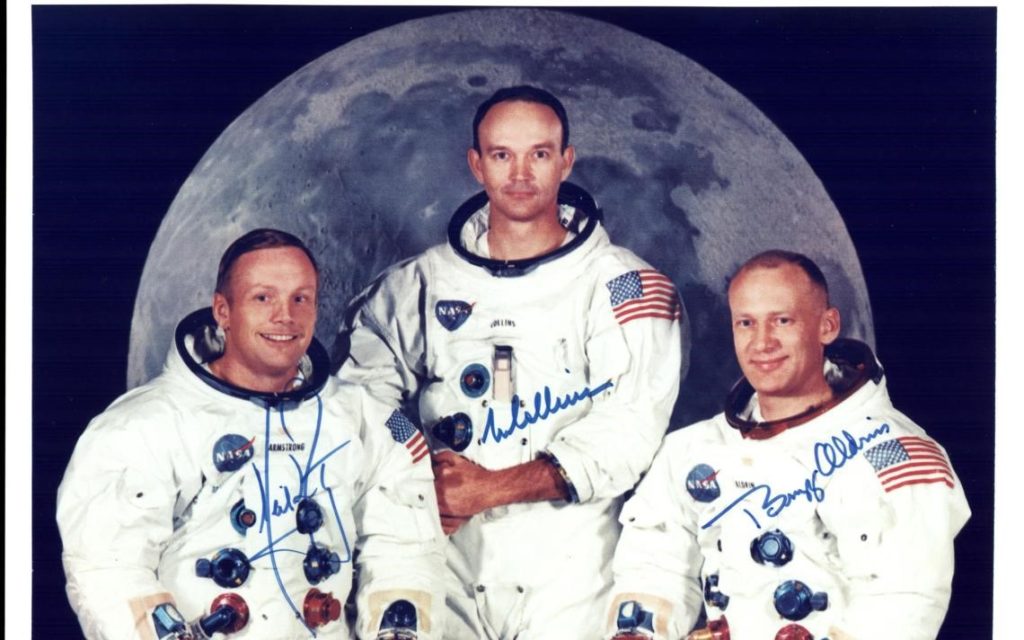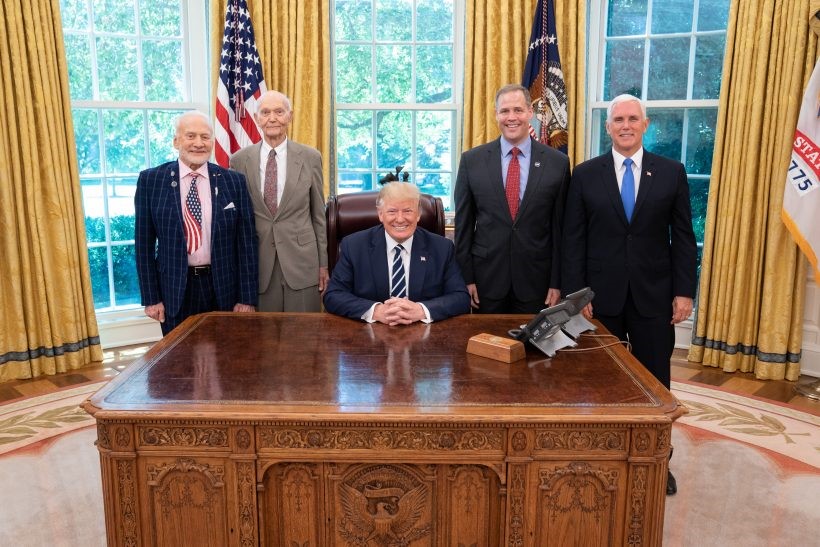“When I consider thy heavens, the work of thy fingers, the moon and the stars, which thou hast ordained; what is man that thou art mindful of him. And the son of man that thou visitest him?” Psalm 8:3-4 . . . Read from a 3-by-5 inch note card by Buzz Aldrin upon returning to earth from his historic trip to the Moon, fifty years ago tomorrow
Buzz Aldrin, an ordained Presbyterian elder, was celebrating the safe conclusion of his historic round trip, when he was the second man to walk on the Moon — after Neil Armstrong took, as he memorably said, “One small step for [a] man; one giant leap for mankind.”
Just after telling Houston, “the Eagle has landed” on the surface of the Moon, leaving the Apollo 11 Mission Commander Michael Collins orbiting in the Command Module above the Moon’s service, and before Neil Armstrong took that “giant leap” on August 20th, Buzz asked Mission Control in Houston for a moment of silence, took communion and read from the other side of that same card the words of John 15:5, “I am the vine, you are the branches. Whoever remains in me, and I in him, will bear much fruit; for you can do nothing without me.”
He broke bread and poured wine from a small container into a small silver chalice, all carried in a small packet from Earth with the full approval of NASA Mission Control — for the first meal consumed on the surface of the Moon. Click here for Buzz’s personal recollections of what led up to that moment, published in 1970 in Guideposts magazine; and enjoy its included video of these historic events.
Notably, his home church, Webster Presbyterian Church just outside of Houston, celebrated with him — in this second related communion dedicated to the Apollo 11 mission, linked to a first one celebrated two weeks earlier in a dedication service before Buzz left for Kennedy Space Center and his historic round trip to the Moon. See below the crew of Apollo 11 mission. Regrettably, Neil Armstrong died in 2012, so he could not join Michael Collins and Buzz Aldrin in celebrating the Golden Anniversary of their most memorable mission.
Indeed, I would be very interested in what he might have told President Trump — and Vice President Pence, who chairs the National Space Council now considering a return to the Moon, as the first step toward travel to Mars. See Buzz and Michael in the Photo below, which also includes NASA Director Jim Bridenstine.
I can’t end this message without linking the recent events and hopeful plans for the future to the efforts of Dr. Klaus Heiss, who was among the founders of High Frontier, and his endless advocacy for establishing a habitat on the Moon to serve as a stepping stone for further space exploration. Click here for a lifetime summary of his most notable efforts, including as High Frontier’s Executive Director after I promised High Frontier’s founder, Retired US Army Lt. General Danny Graham, on his death bed in 1995, that I would keep his aspirations alive as long as I could.
Klaus joined me in that effort. We agreed that I would focus primarily on trying to revive the best system concepts of President Reagan’s Strategic Defense Initiative (SDI) that had been scuttled by the Clinton administration in early 1993, while he would lead High Frontier’s efforts to return us to a more visionary pursuit of manned space missions — activities exemplified by recent directives from President Trump, particularly to return America to a leading visionary role in space.
Regrettably, Klaus died on July 24, 2010 — 9 years ago tomorrow, the Golden Anniversary of when we welcomed home the Apollo 11 astronauts. Were he still with us, I am certain Klaus would be celebrating this anniversary and no doubt would still be leading international efforts that were cut short by his untimely death — indeed, I am sure we would already be on a track that would be exploited by President Trump and his team, aspiring in their efforts to accomplish great things in space for America.
Click here for the Executive Summary of where we were in our advocacy in High Frontier’s December 17, 2003 report for NASA, entitled Columbia: A Permanent Lunar Base. This title memorialized the loss of our seven astronauts on the February 1, 2003 Columbia Shuttle disaster. And it called for a celebratory vision that they would no doubt have also aspired to see accomplished.
Our report began by noting that the then current technology base would support a comprehensive program to reaffirm and reorient the U.S. Human Space Flight Program and reach a succinct goal: Columbia, The First Lunar Base Within A Decade. This base would not only honor those who gave their lives in the Columbia disaster but also give the American taxpayer, every night, an easily seen visual symbol of civilian U.S. effort and accomplishment, with continuous recognition and admiration by all peoples on our planet.
In my Forward to Klaus’ important report, I noted that there were two key missing causal realities undermining the nation’s ability to sustain a viable, vibrant manned space program:
- “The lack, over the past three decades, of any national mandate providing NASA a compelling mission requiring human presence in space;” and, following the lack of such a clearly defined long-term space mission,
- “The lack of sustained government commitment over the past decade to improving U.S. access to space by developing a second generation space transportation system.”
Today, our assessment no doubt would differ only in that it now has been five decades without a national mandate, during which technical experts have differed little about what should be the space exploration steps after the American flag was placed on the Moon in response to President Kennedy’s historic 1961 charge to send Americans to the Moon and return them safely “before this decade is out.”
What has been missing is the same kind of political commitment and will to empower NASA to take the next logical step beyond program Apollo. We referred to the fact that since President Nixon rejected NASA’s 1969 proposed strategic vision, there have been numerous recommendations that included a strategic vision and detailed technical plans for a post-Apollo effort involving full development of low-Earth orbit, permanent outposts on the Moon, and initial journeys to Mars. Ditto, now 17 years later.
Regrettably, no particular architecture has been pursued — leading to decades without a strategic vision to guide NASA in making policy or day-to-day program decisions. And, as the adage goes, “ When you don’t know where you are going, any road will take you there.”
Thus, High Frontier, led by Klaus Heiss, recommended in 2003 that NASA exploit the wealth of available background material from already available studies, technology programs, and associated recommendations dating to the Apollo program — and even earlier recommended costs and schedules for a comprehensive program to reaffirm and reorient the U.S. Human Space Flight Program to reach a succinct goal: Columbia, The First Lunar Base Within A Decade.
High Frontier’s 2010 detailed assessment and recommendations were molded by the following constraints on the program for Human Space Exploration:
- Accomplish within a decade – anything longer is beyond the attention span of U.S. political decision-making in trading off budget requirements.
- Require no substantial increase in NASA budget – a major challenge will lead to major reorientation, but should not more than double the NASA budget.
- Capitalize on past technology achievements and knowledge base – including for the Apollo, Shuttle, and Space Station components, space operations know-how, and related experience of U.S. industry.
- Significantly increase civilian and national security uses of space – by opening and exploiting Cis- and Circumlunar Space for U.S. space activities.
- Assure manageable risk – by reducing long duration space travel uncertainties: effects of micro gravity, cosmic heavy particle radiation, and prolonged isolation.
- Make a historic contribution to the expansion of human enterprise – in particular, to develop an Earth-independent technology base for human habitation outside and ultimately independent of Earth.
- Encourage a new regime for human and economic activities in space – to allow for free enterprise in pursuit of Space activities.
- Conform to the “iron laws” of economics: transportation and time (interest) costs – to accommodate the inescapable “delta-V” and investment interest requirements which increase geometrically with distance from the Earth.
- Stimulate the Nation’s youth and their enthusiasm for exploration, science and technology – requiring complementary programs to involve students and academia along with industry, beyond usual Federal grants and contracts.
- Be a U.S.-led program – with welcome participation of other nations.
We grouped recommendations from numerous past studies to identify three possible goals for NASA’s near-term Human Space Exploration program: 1) Abandon Human Space Flight, 2) Go to Mars, and 3) Establish a human presence on the Moon.
The first is unimaginative and unresponsive to the human thirst for exploration; the second fails several of the above assessment criteria — particularly that the goal be accomplished within a decade — but could be a logical extension of the third, which is, in any case, a precondition for further human exploration of space.
Our High Frontier study concluded that establishing a Lunar base on the Moon within a decade was the logical next step in space exploration. After another 17 years, this conclusion still stands!
Hopefully, President Trump will finally move toward this goal with dispatch.
As noted above, we proposed to name that Lunar base “Columbia,” in honor of the crew of Columbia, and all those who have given their lives in seeking to explore the last frontier of space — and for Columbus, who over 500 years ago opened the sea lanes to the New World. Still worth considering.
I refer you to the above linked Executive Summary for more specifics of Klaus’ December 17 2003 report to NASA.
I want to refer briefly the the very significant additional work that was accomplished next in efforts that Klaus led — in international conferences in Washington, Venice and Rome; important workshops in conjunction with the Global and Entrepreneurial Finance Institute of George Washington University; and private executive level meetings in New York, San Francisco, London, Boston and Washington, DC. Along the way, Klaus held important discussions with Investment Banks, Risk Capital Funds, Energy Companies, Aerospace Companies, Universities and Research Institutions.
Among others who early on shared Klaus’ and High Frontier’s aspirations were William F. Readdy and Chris Vizas.
Bill Readdy was NASA Associate Administrator of the Office of Space Flight, who previously had logged some 672 hours in space on three separate missions — and was impressed by Klaus’s study and participated in several of our international conferences and workshops.
Chris Vizas, an entrepreneur with close ties to Georgetown University, among other important opinion makers and corporate interests, who also strongly supported Klaus’ efforts and in particular was instrumental in arranging an important conference and associated study with Georgetown University devoted to evaluating the financial aspects of the proposed development, including the integration of the technological aspects of achieving our goal. These studies clearly showed financial benefits of being able to exploit the natural resources plentifully available on the Moon — were we to establish the means of exploiting them on-site.
When Dr. Michael Griffin became NASA Administrator in 2006, we met with him and he agreed with our interest in involving the private sector to achieve our designated objectives. Mike had been my first Deputy for Technology when I was Director of President Reagan’s Strategic Defense Initiative (SDI) — and he was very knowledgeable about the technological possibilities based on his past and continuing research.
Mike now serves as the Defense Undersecretary for Research and Engineering and continues advancing technology that can complement and supplement future NASA missions while exploiting Space to benefit our military, civil and private sector interests.
Such activities would be like the Clementine program, jointly sponsored in the 1990s by the Pentagon’s SDI program and NASA. It returned to the Moon for the first time in a quarter century, mapped its entire surface in an unprecedented way, while space qualifying key SDI sensors and mission control computer — and discovering water in the Moon’s polar regions, a potential aid to our future manned exploitation of Lunar resources to support our interest on the earth.
Click here for a discussion of this important joint mission that began on my watch as SDI Director. It includes a photo of the award winning Clementine space craft in the Smithsonian next to NASA’s Lunar Lander like that employed by Armstrong and Aldrin in Apollo 11.
As NASA Administrator in the George W. Bush administration, Mike agreed that NASA would pay for the “transportation costs” for establishing a “Moon Base” if we could get the private sector to pay for building the capability on the Moon to exploit that capability. Under Klaus’ leadership, we actually were well on our way to achieving that objective.
Then when Klaus was taken with a fatal illness…and when we lost him, High Frontier lost our prime mover. And America soon lost its vision for such space development with the election of President Barack Obama; and he and his NASA leadership dramatically redirected NASA’s priorities and funding away from such visionary ventures.
Among our last efforts in moving ahead with our basic ideas was in seeking to establish a Moon Base of operation to exploit the plentiful silicon available on the Lunar surface. This would have combined known means of producing on the Moon solar cells to capture major amounts of solar energy and “beam” it back to Earth using technologies pioneered by the SDI program to replace the Earth’s energy needs.
This thus far lost invention could make an innovative contribution to addressing the current concerns about the viability of our aging and vulnerable electric power grid.
Whoever gets there first with such innovation, will play a dominant role in the unfolding future.
Do such possibilities sound far out? Just another wild idea? Where will America be in such a new Space Race?
Bottom Lines.
The Golden Anniversary of Apollo 11 achievements herald important lessons and challenges for America, which appears to have lost its way on many things — not the least of which is the challenge of Space that once inspired a generation of aspiring Americans, the benefits of which still abound and are being sought by others.
Our leaders are being challenged by other nations, including especially China, and I fear that if we fail to meet that challenge our posterity will rue that failure and pay dearly with the loss of our liberty.
President Trump has set the stage for an alternate outcome with his focus on Space — for both our protection and to exploit for our entrepreneurial benefits.
In considering the future of our space activities, we might consider a replacement for that old saying, “The Sky is the Limit!”
After considering Buzz Aldrin’s memorable quotes from the Bible and the unmatchable authority and power of our God, how about considering that Toy Story chant by Buzz Hello (named after Buzz Aldrin): “To Infinity and Beyond!”
What can you do?
Join us in praying for our nation, and for a rebirth of the freedom sought, achieved and passed to us by those who came before us.
Help us to spread our message to the grass roots and to encourage all “powers that be” to provide for the common defense as they are sworn to do.
Begin by passing this message to your friends and suggest they visit our webpage www.highfrontier.org, for more information. Also, please encourage your sphere of influence to sign up for our weekly e-newsletter.
Encourage them to review our past email messages, posted on www.highfrontier.org, to learn about many details related to the existential man-made and natural EMP threats and how we can protect America against them. I hope you will help us with our urgently needed efforts, which I will be discussing in future messages.
Click here to make a tax deductible gift. If you prefer to mail a check, Please send it High Frontier, 20 F Street 7th Floor, Washington, DC 20001.
E-Mail Message 190723
Please click here to read Past Weekly Updates!
Please help High Frontier continue this important and timely work!
Be sure to follow us on our Social Sites!
If you found this letter via our Social Sites, and you would like to subscribe, please click below!







